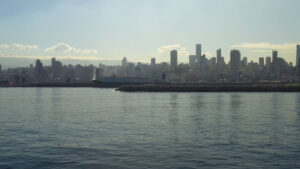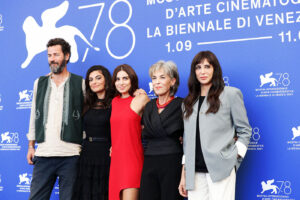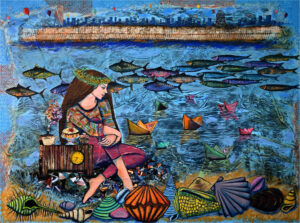
100 miles north of Paris in the town of Jumièges, an art gallery is highlighting contemporary Lebanese photography. Titled “Au bord du monde, vivent nos vertiges” or “Our Vertigo Resides at the Edge of the World,” the show features the work of 16 artists at the Abbaye de Jumièges, a French heritage site in the heart of the Normandy countryside. Through November 6, 2022.
Nada Ghosn
A little more than 100 miles from Paris, in the Seine valley, is an ancient Benedictine abbey. A symbol of Carolingian monarchism and one of the key places of Romanesque art, it was founded in 654 by Saint Philibert, son of a Frankish count of Vasconia, in Jumièges, in a loop of the Seine, thanks to a donation from Clovis II. It is the earliest and the largest of the great Norman abbeys.
Following its founding, Jumièges quickly became one of the most important literary centers of the region, and then a place of exile for the enemies of the Carolingian dynasty. The Abbey de Jumièges was burned and plundered during the Viking invasions in the ninth century, but the Romanesque choir of the great abbey church would be rebuilt in Gothic style in the 13th. With the Norman takeover of the Church of England, the community experienced a period of dynamism and prosperity. Today, almost half of the 400 manuscripts in the library date from that period. During the Wars of Religion, the Abbey was sacked again and then, with the French Revolution, sold and partly demolished. It was only in the 19th century that this monument was refurbished by the mayor of Jumièges. The Abbey attained newfound fame during the Romantic Movement, thanks to Victor Hugo and the historian Robert de Lasteyrie, who described it as “one of the most admirable ruins in France.” In 1947, the Abbey of Jumièges became the property of France, and then of the Department of Seine-Maritime in 2007.
To perpetuate the life of this heritage site, where dialectics and foreign languages were once taught, the Department holds an annual cultural program, including exhibitions of photographs, in which the work of masters such as Josef Koudelka and Henri Cartier-Bresson have been featured. The economic and social crisis that Lebanon has been going through, particularly since the explosion of the port of Beirut on August 4, 2020, led the Department to designate 2022 as the year of France and Lebanon in Normandy. As part of the festivities, Laure d’Hauteville was brought in to organize an exhibition on contemporary Lebanese photography.
A place full of meaning

Laure d’Hauteville has been in contact with Lebanon from childhood, as her parents and grandparents would host Lebanese visitors at their house in Paris during the civil war (1975-1990). After studying art, she realized her dream and went to work in Lebanon in education in 1991, then became an artistic advisor at a bank and finally a cultural journalist. She launched ARTUEL, the first art fair in the Middle East, in Beirut, in 1998, which ran until 2005. D’Hauteville also began bringing Arab artists to France for annual exhibitions. In 2005, following the murder of Rafik Hariri, Lebanon’s former prime minister, she returned to France and studied at the Boule school. She worked for Art Paris and brought it to Abu Dhabi in 2007 and 2008, at the same time as the installation of the Louvre Abu Dhabi project. In 2009, she returned to Lebanon with her husband, Guillaume Taslé d’Héliand, where in 2010 she founded the Beirut Art Fair, dedicated to Middle Eastern art, which ran until 2019. After that year’s October Revolution, she returned to Paris, and following the Beirut port explosion on August 4, 2020, she created MENART FAIR in Paris.
“When the Department of Seine-Maritime called me, I immediately thought of working with a curator in Lebanon, Clémence Cottard Hachem, historian of ancient, modern and contemporary photography. I wanted an exhibition that would be a way to help people understand what the Lebanese in Lebanon are experiencing on a daily basis. It is important that the European public be transported in a dizzying state to comprehend what is going on, and also to see the great quality of the artists,” d’Hauteville said in an interview with The Markaz Review.
“A visit to the Abbey and Jumièges, with its history and environment,” she continued, “inspired our first artistic selections. In a poetic and political way, in a totally different context, a pristine and historically charged place, ‘Our Vertigo Resides at the Edge of the World’ found its place.”
When we enter the abbey, we find ourselves in the penumbra. There begins our initiatory journey, challenged by the photos, the statuettes, the calm of the abbey. “It was necessary to give meaning to the exhibition in relation to the abbot’s residence,” said d’Hauteville. “How to create a dialogue between the photographs and the Gothic and lapidary statuettes present in the place, to render an almost mysterious side between the place and our selections, as if the one and the other complemented each other.”

The exhibition questions the formats of photography itself in the face of the new visual writing that we are seeing from artists young and old. “It was important to exhibit different generations of photographers, such as Laetitia el Hakim and Tarek Haddad, up to the big stars like Joana Hadjitomas and Khalil Joreige, to show how today, thanks to them, we can talk about photographic practices in Lebanon,” said d’Hauteville.
The artists question sculptural writing and its staging in space, thus pushing the limits of more classical documentary photography. Some pieces speak of beauty and softness, others of cruelty, chaos, and violence. Throughout the exhibition, the viewer comes face to face with Lebanon’s ambivalent present. The exhibition does not seek to give answers, but to question how creativity and culture can be central to living in a context of collapse, how we represent what happens to the Lebanese, how we tell stories, how we can sublimate what happens into art.

Water as a starting point
Water is the main focus of the exhibition since the abbey is located in the loops of the Seine. The first part, “Liquid Geographies,” deals with this element in relation to the Lebanese landscape. Water as Lebanon’s great wealth serves as a metaphor for a floating territory, which crystallizes and evaporates.
“The River” by Lara Tabet (2018), opens the tour, above the tomb of the Enervés de Jumièges. According to legend, the two sons of Clovis II were punished by being enervated, i.e., their muscle tendons were burned so that they could not move. The two princes were then placed on a raft without an oar or a rudder, and left to drift, at the mercy of the waves of the Seine, in the icy immensity, where the sky and the water merge, to end up stranded in Jumièges, where a monk from the abbey took them in and cared for them.

“Lara’s work, which analyzes the bacteria in the river of Beirut, made perfect sense… We built all our selections according to the place, which is full of stone sculptures recalling the history of the monastery, such as the head of William the Conqueror or the funeral slab of Agnès Sorel, the monks of the abbey carrying the key to paradise, and others bringing a new meaning to the works. The visitor comes out of it shaken, touched, in full vertigo,” said the curator.
Between past and present
The second part, “Passerelles temporelles,” deals with what has happened in the last 20 years, particularly the troubled relationship between time and memory in Lebanon. “Agenda 1979,”a video, is particularly moving because of its aesthetics, its disturbing music, the very poetic text of Valérie Cachard, with the voice of Gregory Buchakjian in the background, as he reads the contents of a diary dating from 1979 found in the rubble of an abandoned house in Beirut. An instruction manual for the manufacture of mines aimed at destroying a country, it belonged to a former Lebanese militiaman who left for the Soviet Union.
At the beginning of the video, Cachard lists the numerous attacks recorded by governments around the world. Even without any mention of August 4, 2020, everything circles back to this crime, and to the carelessness, even the absolute ignorance of the Lebanese state.
In an interview with TMR, Buchakjian, an art historian teaching at the Lebanese Academy of Fine Arts (ALBA), recalled, “Valerie and I began our collaboration on abandoned habitats more than 10 years ago, as part of my thesis on the subject. We visited and took pictures in a building in Ain Mreissé. It was she who initiated the collection of archival documents. When we realized the project in its artistic form, she edited the book Abandoned Habitats of which she wrote the preface.”

For an exhibition at the Sursock Museum in Beirut, the two artists made a video on abandoned habitats using archives, a kind of filmed performance where they manipulate, describe, and spread out documents and found objects on the floor of a room. “Agenda 79” was produced at the invitation of the Opéra national du Rhin for the Arsmondo Festival. “Since it was an online event, and originally a music festival, I switched to a sound form and contacted Valerie to suggest making a new video,” Buchakjian said.
Since the official end of the civil war in 1990, archives have played a very important role in the work of Lebanese artists. This ranges from the creation of institutions such as the Arab Image Foundation to the realization of artistic projects such as Walid Raad’s Atlas Group, and includes the works of Joanna Hadjithomas and Khalil Joreige, Akram Zaatari and many others. “The archive is important because after the war there was a need to write a history, as institutions had not played this role. Contemporary artists have taken this place that was to be taken,” explained Buchakjian.

“I think the problem is that this war has never been resolved, one could even say that it is not over, even if it has changed form. There was no real conclusion like in the Second World War. The political class is the same, the problems that were at the origin are still there. There was never a real solution, as evidenced by the current state of the country,” Buchakjian lamented.
“Agenda 79” throws the war back in our faces. There is a very strong relationship between the past of the 1970s, the Palestinian presence in Lebanon, the resulting war, and the present, i.e., the explosion of August 4, which was caused by improperly stored ammonium nitrate. “The logic of war has not been extinguished; the sight of the grain silo burning continuously reminds us of this. To see this building burning down is like being consumed. It’s absolutely pathetic,” declared Buchakjian.

Between reality and imagination
The last part, “Songs of Visions,” projects the viewer into the future in a marvelous and tormented way, showing the aesthetics of chaos and cruelty, an almost shamanic vision that the artists project through their practices. Some works deal with photographic material, others tend towards abstraction. “Songs of Vision” is of the sonic order, of the photographic musical matter. The voices carry a desire or a fear, as in Gilbert Hage’s work on zombies, or in Jack Dabaghian’s photographic triptych “Death of the Cedar.”
In Nasri Sayegh and Caroline Tabet’s photography, material the image becomes a metaphor of the psyche. Interviewed for TMR, Tabet explained: “My works are part of the continuity of the research I have been doing for years on the photographic element, an experimental and manual work done with Polaroids.” The trigger for the series “Inner Lives – Anterior” (2020) was the first few weeks of confinement. “At the time, I was living in the Gemmayze neighborhood. I had a balcony overlooking a typical view of Beirut’s urban fabric, with buildings from different eras and old houses with gardens. After the intense months of the thawra (“revolution”), when the neighborhood was in turmoil, the silence and being stuck at home made me need to process directly what I saw without needing to go through a printer.”
“I took Polaroids from my balcony, and then immersed them in hot water with vinegar to create a detachment. Images have two natures: the photographic emulsion of the Polaroid with what was photographed, and what is hidden, which becomes like landscapes of abstraction. These detachments or ‘antecedents’ are part of everything that is hidden from view. I wanted to parallel these two natures to talk about the idea of interiority: the interior of our images that is hidden, but also the observation of a landscape from the inside — as soon as we were confined — at a moment of floating in the history of Lebanon.”

The explosion of the port followed, with all its consequences and collective trauma. Living a few hundred meters from the port, the photographer experienced the event from her home, which transformed in a flash what was around her into a chaotic vision. “This series made sense,” she explained, “because it spoke of something quite difficult to inscribe in time, an image that is embodied to disappear, like this landscape weakened by a disaster. All the problems of the visible and the invisible, of the real and the imaginary, take on dimensions that are all the more palpable in the times we live in. This opens infinite fields of questioning and puts us in front of the uncertainty of the things which surround us, of the realities which we live in our flesh. There is a whole part of imagination which escapes us. What is the real impact of the imaginary on our daily life? If we didn’t have an escape through dreams, life would be even more difficult to absorb.”
Tabet concluded: “To continue to create in the conditions we know is becoming increasingly difficult at all levels. It takes a lot of energy to get things done. The desperation of the people is reflected in all ramifications. In spite of everything, people are doing their best, trying to invest in common projects to keep something alive in a ransacked land.”













![Ali Cherri’s show at Marseille’s [mac] Is Watching You](https://themarkaz.org/wp-content/uploads/2025/09/Ali-Cherri-22Les-Veilleurs22-at-the-mac-Musee-dart-contemporain-de-Marseille-photo-Gregoire-Edouard-Ville-de-Marseille-300x200.jpg)

















































































































































